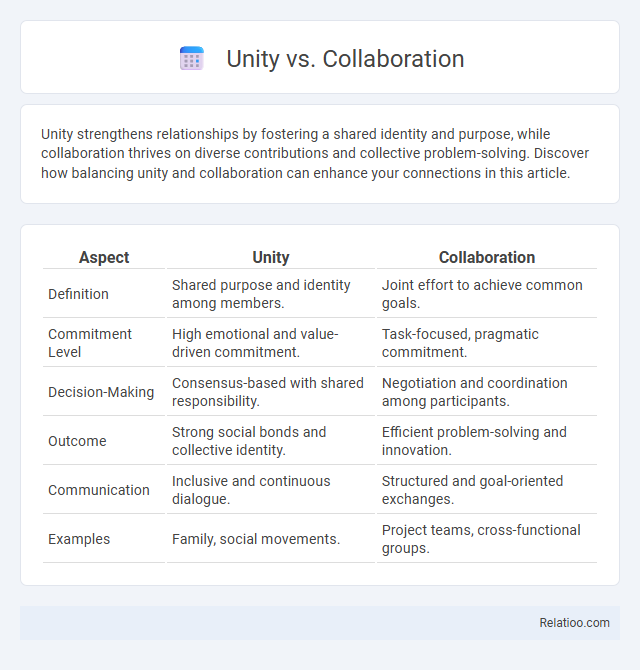Unity strengthens relationships by fostering a shared identity and purpose, while collaboration thrives on diverse contributions and collective problem-solving. Discover how balancing unity and collaboration can enhance your connections in this article.
Table of Comparison
| Aspect | Unity | Collaboration |
|---|---|---|
| Definition | Shared purpose and identity among members. | Joint effort to achieve common goals. |
| Commitment Level | High emotional and value-driven commitment. | Task-focused, pragmatic commitment. |
| Decision-Making | Consensus-based with shared responsibility. | Negotiation and coordination among participants. |
| Outcome | Strong social bonds and collective identity. | Efficient problem-solving and innovation. |
| Communication | Inclusive and continuous dialogue. | Structured and goal-oriented exchanges. |
| Examples | Family, social movements. | Project teams, cross-functional groups. |
Defining Unity and Collaboration
Unity embodies a shared sense of purpose and collective identity that binds individuals towards common goals, fostering cohesion and mutual support. Collaboration involves the active process of working together through communication, coordination, and the exchange of ideas to achieve specific objectives efficiently. To enhance Your organizational effectiveness, understanding the distinction between unity as a foundational bond and collaboration as a dynamic interaction is essential.
Key Differences Between Unity and Collaboration
Unity involves a shared sense of purpose and collective identity among group members, fostering cohesiveness and mutual commitment. Collaboration emphasizes joint effort and interaction where individuals contribute diverse skills to achieve a common goal, highlighting active participation and communication. Key differences include unity being more about emotional bonding and shared values, while collaboration centers on coordinated actions and task-oriented cooperation.
Benefits of Unity in Team Environments
Unity in team environments fosters seamless communication, enhances trust, and drives collective problem-solving, resulting in higher productivity and innovation. Shared goals and aligned values under unity reduce conflicts and create a cohesive work atmosphere, boosting employee morale. Teams practicing unity experience improved decision-making efficiency, leveraging diverse skills toward common success.
Advantages of Collaboration in the Workplace
Collaboration in the workplace enhances creativity and problem-solving by bringing diverse perspectives together, leading to more innovative solutions than working in isolation. Your team benefits from improved communication, fostering trust and better decision-making that aligns with organizational goals. These advantages result in increased productivity and a stronger sense of shared purpose, setting collaboration apart from mere unity or individual effort.
When to Prioritize Unity Over Collaboration
Prioritize unity over collaboration when swift decision-making and consistent vision are critical to your organization's success. Unity fosters alignment and cohesion, reducing conflicts that can arise from diverse inputs during collaboration. Your team benefits from a unified direction when time constraints or strategic clarity outweigh the need for broad consensus.
When Collaboration Outshines Unity
Collaboration outshines unity when diverse skills and perspectives combine to drive innovation and problem-solving beyond a shared mindset. Your team leverages complementary strengths, fostering creativity and adaptability that pure unity alone may lack. In complex projects, collaboration accelerates results by enabling dynamic interactions and continuous learning among members.
Potential Challenges of Unity and Collaboration
Unity and collaboration often face potential challenges such as communication breakdowns and conflicting priorities which can hinder progress. The rigidity of unity may limit individual creativity and adaptability, while collaboration can suffer from coordination difficulties and resource allocation issues. Addressing these challenges requires balancing cohesive group identity with flexible teamwork strategies to maximize effectiveness.
Strategies to Foster Unity Among Teams
Effective strategies to foster unity among teams include promoting open communication channels that encourage transparency and trust, ensuring each team member's contributions are recognized to build a shared sense of purpose. Implementing collaborative tools like project management software facilitates seamless coordination and real-time feedback, enhancing collective problem-solving abilities. Emphasizing diversity and inclusion alongside shared goals helps create an environment where unity thrives through mutual respect and aligned objectives.
Effective Methods to Enhance Collaboration
Effective methods to enhance collaboration focus on clear communication, defined roles, and shared goals that unify team efforts toward a common purpose. Leveraging collaboration tools like Slack, Trello, or Microsoft Teams streamlines workflow, enabling your team to coordinate tasks and track progress efficiently. Encouraging regular feedback and fostering a culture of trust help maintain unity, ensuring that your collaborative efforts result in productive and innovative outcomes.
Choosing the Right Approach: Unity vs Collaboration
Choosing between unity and collaboration depends on your organization's goals and culture; unity emphasizes shared values and a cohesive vision, while collaboration prioritizes diverse inputs and joint problem-solving. Unity fosters alignment and strong group identity, which can streamline decision-making and strengthen commitment to common objectives. Collaboration encourages innovation and adaptability by leveraging varied perspectives, making it ideal for complex or rapidly changing environments where your team must work together creatively.

Infographic: Unity vs Collaboration
 relatioo.com
relatioo.com